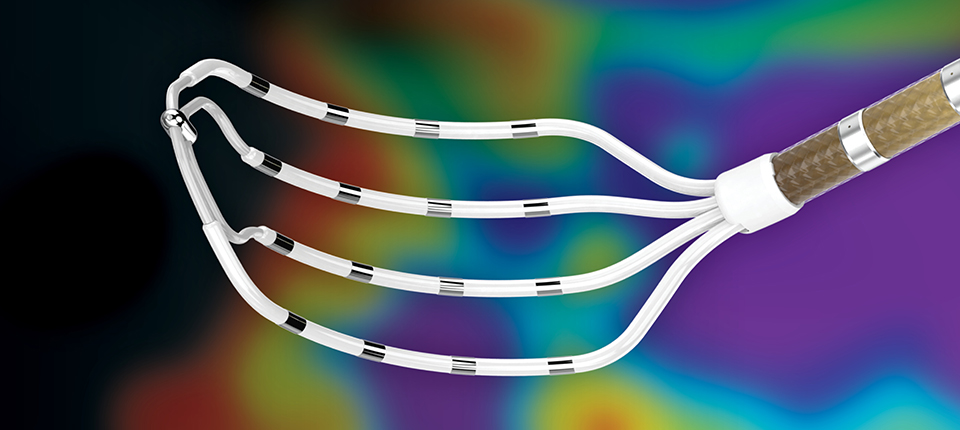INDICATIONS, SAFETY & WARNINGS
Indications: The Advisor™ HD Grid Mapping Catheter, Sensor Enabled™, is indicated for multiple electrode electrophysiological mapping of cardiac structures in the heart, i.e., recording or stimulation only. This catheter is intended to obtain electrograms in the atrial and ventricular regions of the heart. Contraindications: The catheter is contraindicated for patients with prosthetic valves and patients with left atrial thrombus or myxoma, or interatrial baffle or patch via transseptal approach. This device should not be used with patients with active systemic infections. The catheter is contraindicated in patients who cannot be anticoagulated or infused with heparinized saline.
Caution: This product is intended for use by or under the direction of a physician. Prior to use, reference Instructions for Use, inside the product carton (when available) or at eifu.abbottvascular.com or at manuals.sjm.com for more detailed information on Indications, Contraindications, Warnings, Precautions and Adverse Events.
Warnings: Cardiac catheterization procedures present the potential for significant x-ray exposure, which can result in acute radiation injury as well as increased risk for somatic and genetic effects, to both patients and laboratory staff due to the x-ray beam intensity and duration of the fluoroscopic imaging. Careful consideration must therefore be given for the use of this catheter in pregnant women. Catheter entrapment within the heart or blood vessels is a possible complication of electrophysiology procedures. Vascular perforation or dissection is an inherent risk of any electrode placement. Careful catheter manipulation must be performed in order to avoid device component damage, thromboembolism, cerebrovascular accident, cardiac damage, perforation, pericardial effusion, or tamponade. Risks associated with electrical stimulation may include, but are not limited to, the induction of arrhythmias, such as atrial fibrillation (AF), ventricular tachycardia (VT) requiring cardioversion, and ventricular fibrillation (VF). Catheter materials are not compatible with magnetic resonance imaging (MRI).
Precautions: Maintain an activated clotting time (ACT) of greater than 300 seconds at all times during use of the catheter. This includes when the catheter is used in the right side of the heart. To prevent entanglement with concomitantly used catheters, use care when using the catheter in the proximity of the other catheters. Maintain constant irrigation to prevent coagulation on the distal paddle. Inspect irrigation tubing for obstructions, such as kinks and air bubbles. If irrigation is interrupted, remove the catheter from the patient and inspect the catheter. Ensure that the irrigation ports are patent and flush the catheter prior to re-insertion. Always straighten the catheter before insertion or withdrawal. Do not use if the catheter appears damaged, kinked, or if there is difficulty in deflecting the distal section to achieve the desired curve. Do not use if the catheter does not hold its curve and/or if any of the irrigation ports are blocked. Catheter advancement must be performed under fluoroscopic guidance to minimize the risk of cardiac damage, perforation, or tamponade.
TactiCath Contact Force Ablation Catheter, Sensor Enabled
CAUTION: This product is intended for use by or under the direction of a physician. Prior to use, reference Instructions for Use, inside the product carton (when available) or at eifu.abbottvascular.com or at manuals.sjm.com for more detailed information on Indications, Contraindications, Warnings, Precautions and Adverse Events.
Indications: The TactiCath Contact Force Ablation Catheter, Sensor Enabled is indicated for use in cardiac electrophysiological mapping and for the treatment of drug refractory recurrent symptomatic paroxysmal atrial fibrillation, when used in conjunction with a compatible RF generator and three-dimensional mapping system.
Contraindications: Do not use for any of the following conditions: certain recent heart surgery; prosthetic valves; active systemic infection; use in coronary vasculature; myxoma or intracardiac thrombus, or an interatrial baffle or patch; retrograde trans-aortic approach in patients with aortic valve replacement.
Warnings: It is important to carefully titrate RF power; too high RF power during ablation may lead to perforation caused by steam pop. Contact force in excess of 70 g may not improve the characteristics of lesion formation and may increase the risk for perforation during manipulation of the catheter. Patients undergoing septal accessory pathway ablation are at risk for complete AV block which requires the implantation of a permanent pacemaker. Implantable pacemakers and implantable cardioverter/defibrillator may be adversely affected by RF current. Always verify the tubing and catheter have been properly cleared of air prior to inserting the catheter into the vasculature since entrapped air can cause potential injury or fatality. The temperature data transmitted by the sensor in this catheter is representative of the irrigated electrode only and does not provide tissue temperature data.
Precautions: The long-term risks of protracted fluoroscopy and creation of RF induced lesions have not been established; careful consideration must be given for the use of the device in prepubescent children. When using the catheter with conventional EP lab system or with a 3D navigational system, careful catheter manipulation must be performed, in order to avoid cardiac damage, perforation, or tamponade. Always maintain a constant saline irrigation flow to prevent coagulation within the lumen of the catheter. Access the left side of the heart via a transseptal puncture. Care should be taken when ablating near structures such as the sino-atrial and AV nodes.
Potential Adverse Events: Potential adverse events include, but are not limited to, cardiovascular related complications, including groin hematoma, pericardial effusion and infection. More serious complications are rare, which can include damage to the heart or blood vessels; blood clots (which may lead to stroke); tamponade; severe pulmonary vein stenosis; heart attack; esophageal fistula, or death. Please refer to the Instructions for Use for a complete list.
